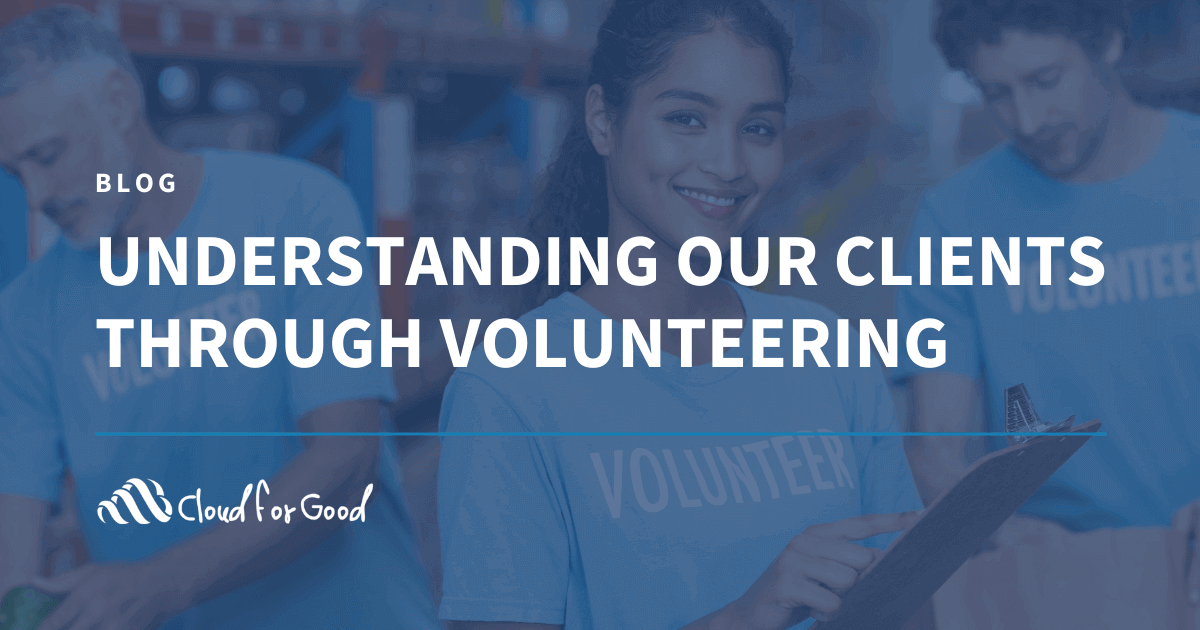Being part of the Cloud for Good team means that helping nonprofits is an everyday part of our job. We have the tools and the team to truly empower an organization to transform with the power of Salesforce and the Salesforce ecosystem.
Though I have worked with hundreds of nonprofits over the years helping them find the right Salesforce solution, personally I have never worked for a nonprofit. While I value my work experience, it still isn’t quite the same as actually experiencing what they are going through on a daily basis. You know the saying, “You can’t understand someone until you’ve walked a mile in their shoes.”
Or, as Atticus Finch said to Scout in Harper Lee’s To Kill A Mockingbird:
“If you can learn a simple trick, Scout, you’ll get along a lot better with all kinds of folks. You never really understand a person until you consider things from his point of view, until you climb inside of his skin and walk around in it.”
The Start of Something Great
In line with Cloud for Good’s mission, we follow the Salesforce.org philanthropic 1-1-1 model, which donates 1% of Cloud for Good equity, 1% of Cloud for Good Product and 1% of Cloud for Good employee time back to the community. We donate our time in two ways, company-wide service days and individual volunteer time.
I chose to spend my volunteer time by combining my musical passion with my love for animals. After connecting with a local nonprofit, a friend and I decided to organize a music fundraiser. My friend had benefited from this nonprofit’s service before and we were both eager to give back.
We came up with an overly simple plan. We would play a gig, put out a tip jar and donate all tips plus our gig fee to the nonprofit. Easy! Or so we thought.
As plans often do, they morphed as we became more ambitious. The event quickly became a small music festival including 9 local acts.
In collaboration with the nonprofit, we began to organize on-site, day-of fundraising activities while also creating a strategy to sell sponsorships instead of just having a tip jar. We also began coordinating with the venue on seating, marketing, and sponsorship accommodations. It spurred a larger marketing campaign via email and social media, and it grew to a point where we needed a tool to manage the participants, day of logistics, musician check-in, sound checks, set changes, and even online fundraising!
Gaining Perspective
Having never organized a fundraiser or festival before, this was all new to me. As the event continued to grow and evolve I did what anyone else would do – I spun up a spreadsheet (yup, that’s right, I did, it’s a bit cathartic admitting this).
I had performers, venue contacts, attendees, nonprofit contacts and other resources listed, their statuses, even specifics like songs to be performed. But wait, I wasn’t done! I spun up a second document with some checklists and tasks, additional notes, email correspondence templates and so on.
That’s when it dawned on me. What have I become?
I thought if anyone from Cloud for Good found out about this I would be shunned, cast aside like a leper (I kid of course). This is exactly what we help our clients avoid! For so long I have helped nonprofits retire these types of spreadsheets! At times I have seen spreadsheets with formulas, color-coded cells, and pivot tables. You name it, I have seen it. Some have been spectacularly complicated and a huge burden to maintain. And yet, I myself started heading down that same path. How easy it was to fall into this trap. My spreadsheet started innocently enough, but then it grew like a virus!
Never Too Small for Salesforce
So, what have I learned? That with a little pre-planning next year, we can become more efficient, effective and create more benefit by leveraging tools like Salesforce NPSP for tracking participants, venues, sponsors and invitees. By integrating with an online fundraising tool, we can better manage online giving and track the fundraising effectiveness of this event by correlating donations to it. We can more effectively manage communications with everyone involved by leveraging an email tool for drip campaigns and better communications. We could even capture event attendees through an event management tool.
This is a very small nonprofit we are working with. And in the grand scheme of things, this was a small event. We all know that you are never too small to spin up a spreadsheet to manage your processes. However, you are also never too small to leverage all of the benefits of Salesforce either. No matter the function or the size or the task, all nonprofits can benefit from Salesforce.
This is the first time we have put on this event, but I am eager to make it an annual activity. I look forward to leveraging Salesforce next year so I can avoid a lot of manual, administrative tasks and focus on fundraising and music. What I most look forward to is applying the lessons learned from this very personal experience to working with our future clients. Even after all of these years doing what I do, I now have a different perspective on what they are going through. I have walked a mile in their shoes, climbed inside their skin and walked around a bit.
It is funny to reflect and realize, I thought my volunteering would help the nonprofit I was volunteering for when in reality, it helped me so much more.
You may also enjoy:





